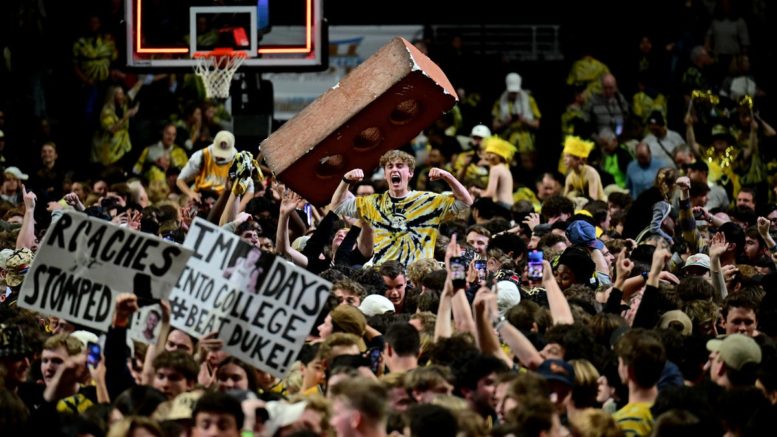For decades, court stormings have college basketball’s most controversial tradition. On one hand, it’s a sign of exuberant fans and school pride, but in an increasingly anxious sports world, it’s also a threat to the safety of players. As Caitlyn Clark discovered last month against Ohio State, the threat of being on the wrong end of a court storming incident is even greater for top-10 teams and marquee players.
On Saturday, rabid fans stormed the court after Wake Forest’s defeat of Duke. The sight of hundreds of irrational, adrenaline-filled fans and with a compulsion to sprint on their home court is a common sight these days, but students stampeding into Duke seven-footer Kyle Filipowski are what has Wake Forest in the headlines for all the wrong reasons.
The rate of court stormings seems to have picked up in recent years, as the bar for what’s considered an upset worthy of rushing the floor has lowered and upsets of all kinds have become more common in the one-and-done era. However, on Saturday, brainless Wake blockheads who ran into Filipowski and potentially injured him may have been the final straw in the court storming epidemic.
After Filipowski was helped off the court with either a balky knee or ankle, Duke head coach Jon Scheyer questioned when court storming would be banned and bemoaned how court stormings have become more dangerous than when he was an active player in 2010.
“Disappointed we lost, but for me it’s more concern about the well-being of our guys. Flip sprains his ankle, when are we going to ban court-storming?” asked Scheyer. “When are we going to ban that? How many times does a player have to get into something where they get punched, or they get pushed, or they get taunted right in their face? It’s a dangerous thing.”
Added Scheyer, “When I played, at least it was 10 seconds and you could storm the court. Now the buzzer doesn’t even go off and they’re running on the floor. This has happened to us a bunch this year.”
Scheyer might be looking back on the halcyon days of court stormings with rose-colored glasses. Scheyer was on the floor during a Feb. 15, 2009 upset loss to Boston College when their fans stormed the court almost immediately after the final buzzer without incident. He’s not wrong, though. Court stormings are a dangerous scenario wrought with raw emotions that leaves open the possibility for players to get hurt. Exhibit A was Saturday, with Filipowski taking a step forward as a Wake Forest fan tripped over it, causing both to stumble, while simultaneously getting shoved and stumbling forward into another.
Whether Filipowski initiated the initial contact , shoved the fan, or ran into his knee (or if that was just his natural stride) is irrelevant. Court trespassers don’t get the benefit of the doubt, which is what led to Wake Forest’s athletic director issuing a statement expressing regret. If Filipowski and Duke invaded through the student section throwing ‘bows and knocking fans senseless with their knees after an authoritative win, the argument would be just as cut and dry.
Players shouldn’t have to secure escape routes off the court by pushing through hostile territory like they’re trying to make it to the last flight out of Saigon, but beating Duke is enough to make the average basketball fan lose their senses. Jay Bilas also joined the chorus of critics who suggested banning court storming, but good luck trying to stop it.
It’s been 10 years since the SEC “banned” court stormings. Earlier this week, LSU was fined $100,000 after fans, including Angel Reese, stormed the court when they defeated No. 17 Kentucky. For their next violation, the fine will increase to $250,000 and $500,000 for a third one. It’s a punitive fine that’s enough to make administrators root for a “moral victory” and an L in the loss column against a highly touted ranked team rather than a pyrrhic victory to their athletic department’s budgets.
However, students who owe tens of thousands in tuition money, drunk fans affiliated with the school or not, and the venn diagram of both, don’t care about financial penalties their university has to pay. Seriously, watch that clip again of Wake fans and tell me where these mindless imbeciles are in such a hurry to get to, and tell me they care about a fine. They’re as rabid as Last of Us clickers or those drivers on icy roads spilling into 60-car pile ups because they lack common sense.
We can wag our fingers like Nancy Reagan at teenagers high on adrenaline, demanding fans “just say no” to the intoxicating high of storming the court, but what’s that really going to do? NCAA and member schools have the funds to hire military contractors to keep the peace or hire bouncers employed by bars in their nearby college town if the militarization of college basketball court security makes people queasy. But there’s still far too many fans for any arena’s security apparatus to keep at bay.
New York City may not be the mecca of college hoops, but we do have a tried and true method for preventing invasions. Glue traps work for mice so maybe lining those around the floor might be more efficient. Experts have suggested identifying trespassers and revoking their ticket privileges as a deterrent worth exploring. However, pouring Jan. 6 energy into court stormings is unrealistic, and every college arena doesn’t have Yankee Stadium’s state-of-the-art facial recognition surveillance capabilities.
Maybe it’s time for a little cooperation and a middle ground in the form of college basketball implementing their own shot clock, but for fans. If the crux of the issue is getting players off the court, then implementing a 24-second court storming countdown similar to the one Scheyer suggested is worth exploring. Telling college kids not to do something is just going to have the oppositional defiance effect, but a few seconds of patience after the clock expires never hurt anyone. If fans are going to storm the court, at least arrange a protocol for doing so. It’s better than what the sport has in place now.
Original source here
#Kyle #Filipowski #injury #fans #wonx27t #quit #storming #court





